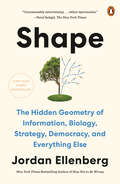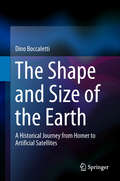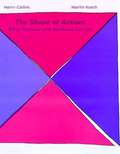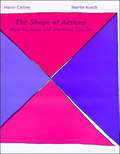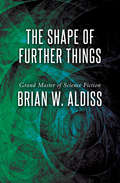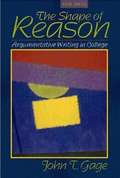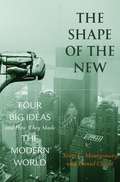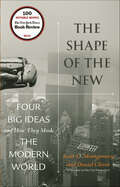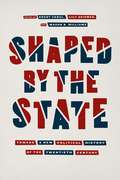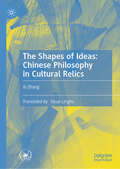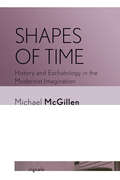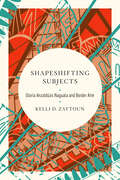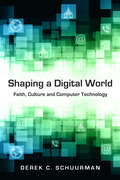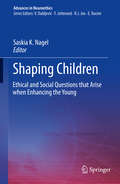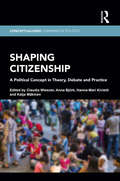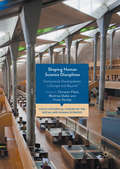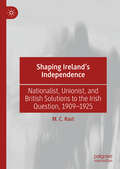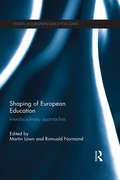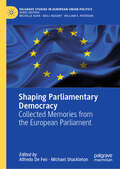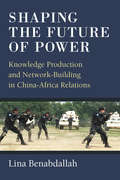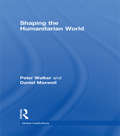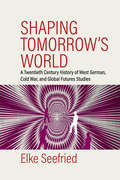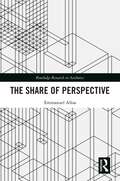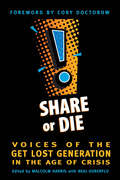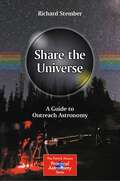- Table View
- List View
Shape: The Hidden Geometry of Information, Biology, Strategy, Democracy, and Everything Else
by Jordan EllenbergFrom the New York Times-bestselling author of How Not to Be Wrong—himself a world-class geometer—a far-ranging exploration of the power of geometry, which turns out to help us think better about practically everything. <P><P>How should a democracy choose its representatives? How can you stop a pandemic from sweeping the world? How do computers learn to play Go, and why is learning Go so much easier for them than learning to read a sentence? Can ancient Greek proportions predict the stock market? (Sorry, no.) What should your kids learn in school if they really want to learn to think? All these are questions about geometry. For real. <P><P>If you're like most people, geometry is a sterile and dimly remembered exercise you gladly left behind in the dust of ninth grade, along with your braces and active romantic interest in pop singers. If you recall any of it, it's plodding through a series of miniscule steps only to prove some fact about triangles that was obvious to you in the first place. That's not geometry. Okay, it is geometry, but only a tiny part, which has as much to do with geometry in all its flush modern richness as conjugating a verb has to do with a great novel. <P><P>Shape reveals the geometry underneath some of the most important scientific, political, and philosophical problems we face. Geometry asks: Where are things? Which things are near each other? How can you get from one thing to another thing? Those are important questions. The word "geometry," from the Greek for "measuring the world." If anything, that's an undersell. Geometry doesn't just measure the world—it explains it. Shape shows us how. <P><P><b>A New York Times Bestseller</b>
The Shape and Size of the Earth: A Historical Journey from Homer to Artificial Satellites
by Dino BoccalettiThis book describes in detail the various theories on the shape of the Earth from classical antiquity to the present day and examines how measurements of its form and dimensions have evolved throughout this period. The origins of the notion of the sphericity of the Earth are explained, dating back to Eratosthenes and beyond, and detailed attention is paid to the struggle to establish key discoveries as part of the cultural heritage of humanity. In this context, the roles played by the Catholic Church and the philosophers of the Middle Ages are scrutinized. Later contributions by such luminaries as Richer, Newton, Clairaut, Maupertuis, and Delambre are thoroughly reviewed, with exploration of the importance of mathematics in their geodetic enterprises. The culmination of progress in scientific research is the recognition that the reference figure is not a sphere but rather a geoid and that the earth’s shape is oblate. Today, satellite geodesy permits the solution of geodetic problems by means of precise measurements. Narrating this fascinating story from the very beginning not only casts light on our emerging understanding of the figure of the Earth but also offers profound insights into the broader evolution of human thought.
The Shape of Actions
by Harry CollinsWhat can humans do? What can machines do? How do humans delegate actions to machines? In this book, Harry Collins and Martin Kusch combine insights from sociology and philosophy to provide a novel answer to these increasingly important questions. The authors begin by distinguishing between two basic types of intentional behavior, which they call polimorphic actions and mimeomorphicb actions. Polimorphic actions (such as writing a love letter) are ones that community members expect to vary with social context. Mimeomorphic actions (such a swinging a golf club) do not vary. Although machines cannot act, they can mimic mimeomorphic actions. Mimeomorphic actions are thus the crucial link between what humans can do and what machines can do. Following a presentation of their detailed categorization of actions, the authors apply their approach to a broad range of human-machine interactions and to learning. Key examples include bicycle riding and the many varieties of writing machines. They also show how their theory can be used to explain the operation of organizations such as restaurants and armies. Finally, they look at a historical case&--the technological development of the air pump&--applying their categorization of actions to the processes of mechanization and automation. Automation, they argue, can occur only where what we want to bring about can be brought about through mimeomorphic action.
The Shape of Actions: What Humans and Machines Can Do
by Harry Collins Martin KuschWhat can humans do? What can machines do? How do humans delegate actions to machines? In this book, Harry Collins and Martin Kusch combine insights from sociology and philosophy to provide a novel answer to these increasingly important questions. The authors begin by distinguishing between two basic types of intentional behavior, which they call polimorphic actions and mimeomorphic actions. Polimorphic actions (such as writing a love letter) are ones that community members expect to vary with social context. Mimeomorphic actions (such a swinging a golf club) do not vary. Although machines cannot act, they can mimic mimeomorphic actions. Mimeomorphic actions are thus the crucial link between what humans can do and what machines can do.Following a presentation of their detailed categorization of actions, the authors apply their approach to a broad range of human-machine interactions and to learning. Key examples include bicycle riding and the many varieties of writing machines. They also show how their theory can be used to explain the operation of organizations such as restaurants and armies. Finally, they look at a historical case—the technological development of the air pump—applying their categorization of actions to the processes of mechanization and automation. Automation, they argue, can occur only where what we want to bring about can be brought about through mimeomorphic action.
The Shape of Further Things
by Brian W. AldissThe sci-fi author behind Steven Spielberg&’s A.I. shares his thoughts on the present, the future, and his own work and life. &“We are infinitely rich, yet we mess about with penny-in-the-slot machines,&” writes Brian W. Aldiss in this autobiographical work written over the course of one month. From his Oxfordshire home, he ruminates on dreams, education, the role of technology in our lives, the rise and function of science fiction, and a variety of other topics. The Shape of Further Things is a window into the life and mind of a Science Fiction Grand Master. Winner of two Hugo Awards, one Nebula Award, and named a Grand Master by the Science Fiction Writers of America, Brian W. Aldiss challenged readers&’ minds for over fifty years with literate, thought-provoking, and inventive science fiction. &“This short book flows with large ideas, a time capsule now from the grandest of writers.&” —SF Site
The Shape of Reason: Argumentative Writing in College
by John T. GageArgumentative reasoning addresses ideas that the writer takes seriously enough to want to explore and support with good reasons.
The Shape of the New
by Scott L. Montgomery Daniel ChirotThis panoramic book tells the story of how revolutionary ideas from the Enlightenment about freedom, equality, evolution, and democracy have reverberated through modern history and shaped the world as we know it today.A testament to the enduring power of ideas, The Shape of the New offers unforgettable portraits of Adam Smith, Thomas Jefferson, Alexander Hamilton, Charles Darwin, and Karl Marx--heirs of the Enlightenment who embodied its highest ideals about progress--and shows how their thoughts, over time and in the hands of their followers and opponents, transformed the very nature of our beliefs, institutions, economies, and politics. Yet these ideas also hold contradictions. They have been used in the service of brutal systems such as slavery and colonialism, been appropriated and twisted by monsters like Stalin and Hitler, and provoked reactions against the Enlightenment's legacy by Islamic Salafists and the Christian Religious Right.The Shape of the New argues that it is impossible to understand the ideological and political conflicts of our own time without familiarizing ourselves with the history and internal tensions of these world-changing ideas. With passion and conviction, it exhorts us to recognize the central importance of these ideas as historical forces and pillars of the Western humanistic tradition. It makes the case that to read the works of the great thinkers is to gain invaluable insights into the ideas that have shaped how we think and what we believe.
The Shape of the New: Four Big Ideas and How They Made the Modern World
by Scott L. Montgomery Daniel ChirotHow four revolutionary ideas from the Enlightenment shaped today's worldThis panoramic book tells the story of how revolutionary ideas from the Enlightenment about freedom, equality, evolution, and democracy have reverberated through modern history and shaped the world as we know it today.A testament to the enduring power of ideas, The Shape of the New offers unforgettable portraits of Adam Smith, Thomas Jefferson, Alexander Hamilton, Charles Darwin, and Karl Marx—heirs of the Enlightenment who embodied its highest ideals about progress—and shows how their thoughts, over time and in the hands of their followers and opponents, transformed the very nature of our beliefs, institutions, economies, and politics. Yet these ideas also hold contradictions. They have been used in the service of brutal systems such as slavery and colonialism, been appropriated and twisted by monsters like Stalin and Hitler, and provoked reactions against the Enlightenment's legacy by Islamic Salafists and the Christian Religious Right.The Shape of the New argues that it is impossible to understand the ideological and political conflicts of our own time without familiarizing ourselves with the history and internal tensions of these world-changing ideas. With passion and conviction, it exhorts us to recognize the central importance of these ideas as historical forces and pillars of the Western humanistic tradition. It makes the case that to read the works of the great thinkers is to gain invaluable insights into the ideas that have shaped how we think and what we believe.
Shaped by the State: Toward a New Political History of the Twentieth Century
by Brent Cebul Lily Geismer Mason B. WilliamsAmerican political history has been built around narratives of crisis, in which what “counts” are the moments when seemingly stable political orders collapse and new ones rise from the ashes. But while crisis-centered frameworks can make sense of certain dimensions of political culture, partisan change, and governance, they also often steal attention from the production of categories like race, gender, and citizenship status that transcend the usual break points in American history. Brent Cebul, Lily Geismer, and Mason B. Williams have brought together first-rate scholars from a wide range of subfields who are making structures of state power—not moments of crisis or partisan realignment—integral to their analyses. All of the contributors see political history as defined less by elite subjects than by tensions between state and economy, state and society, and state and subject—tensions that reveal continuities as much as disjunctures. This broader definition incorporates investigations of the crosscurrents of power, race, and identity; the recent turns toward the history of capitalism and transnational history; and an evolving understanding of American political development that cuts across eras of seeming liberal, conservative, or neoliberal ascendance. The result is a rich revelation of what political history is today.
The Shapes of Ideas: Chinese Philosophy in Cultural Relics
by Xi ZhangThe book combines Chinese philosophy and historical knowledge and delivers the core ideas of Chinese philosophy from 72 elaborately selected pieces of cultural relics in 18 topics. Based on the structure of “Cosmology-Ontology-Theory of Mind-Nature” for ancient Chinese philosophy, the author probes the new achievements in recent years, and portrays the Chinese world of thought for its vivid transformation from pre-philosophical period to early modern period, from elitism taste to popularized orientation. By narrating the nature of being, the author brings the thought essence of ancient Chinese philosophy to the readers, meanwhile mentions the society and history, and therefore sketches the interaction among the three objects. The book elucidates the wisdom of Chinese philosophy contained in cultural relics and reveals the thought and exploration of ancient Chinese sages to the secrets of human nature.
Shapes of Time: History and Eschatology in the Modernist Imagination (Signale: Modern German Letters, Cultures, and Thought)
by Michael McGillenShapes of Time explores how concepts of time and history were spatialized in early twentieth-century German thought. Michael McGillen locates efforts in German modernism to conceive of alternative shapes of time—beyond those of historicism and nineteenth-century philosophies of history—at the boundary between secular and theological discourses. By analyzing canonical works of German modernism—those of Karl Barth, Franz Rosenzweig, Siegfried Kracauer, and Robert Musil—he identifies the ways in which spatial imagery and metaphors were employed to both separate the end of history from a narrative framework and to map the liminal relation between history and eschatology.Drawing on theories and practices as disparate as constructivism, non-Euclidean geometry, photography, and urban architecture, Shapes of Time presents original connections between modernism, theology, and mathematics as played out within the canon of twentieth-century German letters. Concepts of temporal and spatial form, McGillen contends, contribute to the understanding not only of modernist literature but also of larger theoretical concerns within modern cultural and intellectual history.
Shapeshifting Subjects: Gloria Anzaldua's Naguala and Border Arte (Transformations: Womanist studies)
by Kelli D. ZaytounKelli D. Zaytoun draws on Gloria Anzaldúa's thought to present a radically inclusive and expansive approach to selfhood, creativity, scholarship, healing, coalition-building, and activism. Zaytoun focuses on Anzaldúa's naguala/ shapeshifter, a concept of nagualismo. This groundbreaking theory of subjectivity details a dynamic relationship between “inner work” and "public acts" that strengthens individuals' roles in social and transformative justice work. Zaytoun's detailed emphasis on la naguala, and Nahua metaphysics specifically, brings much needed attention to Anzaldúa's long-overlooked contribution to the study of subjectivity. The result is a women and queer of color, feminist-focused work aimed at scholars in many disciplines and intended to overcome barriers separating the academy from everyday life and community. An original and moving analysis, Shapeshifting Subjects draws on unpublished archival material to apply Anzaldúa's ideas to new areas of thought and action.
Shaping a Digital World: Faith, Culture and Computer Technology
by Derek C. SchuurmanDigital technology has become a ubiquitous feature of modern life. Our increasingly fast-paced world seems more and more remote from the world narrated in Scripture. But despite its pervasiveness, there remains a dearth of theological reflection about computer technology and what it means to live as a faithful Christian in a digitally-saturated society. In this thoughtful and timely book, Derek Schuurman provides a brief theology of technology, rooted in the Reformed tradition and oriented around the grand themes of creation, fall, redemption and new creation. He combines a concise, accessible style with penetrating cultural and theological analysis. Building on the work of Jacques Ellul, Marshall McLuhan and Neil Postman, and drawing from a wide range of Reformed thinkers, Schuurman situates computer technology within the big picture of the biblical story. Technology is not neutral, but neither is there an exclusively "Christian" form of technological production and use. Instead, Schuurman guides us to see the digital world as part of God?s good creation, fallen yet redeemable according to the law of God. Responsibly used, technology can become an integral part of God?s shalom for the earth.
Shaping Children: Ethical and Social Questions that Arise when Enhancing the Young (Advances in Neuroethics)
by Saskia K. NagelThe volume offers a unique collection of articles on pediatric neuroenhancement from an international and multidisciplinary perspective. In recent years, the topic of “neuroenhancement” has become increasingly relevant in academia and practice, as well as among the public. While autonomous adults are free to choose neuroenhancement, in children it presents its own ethical, social, legal, and developmental issues. A plethora of potential (neurotechnological) enhancement agents are on the market. While the manifold issues surrounding the topic have been extensively discussed, there is little work on the specific questions that arise in children and adolescents. This book addresses this gap in the literature: Next to conceptual and normative work on autonomy and self-control, the collection explores the implications for parenting and schooling, and provides input for a discussion of public attitudes. It is a valuable resource for the different academic communities confronted with questions of how to evaluate and approach enhancement in children and is of interest to neuroethicists, scholars in applied ethics and neurology, psychiatrists and psychologists as well as scientists developing enhancement interventions for children.
Shaping Citizenship: A Political Concept in Theory, Debate and Practice (Conceptualising Comparative Politics)
by Claudia Wiesner Anna Björk Hanna-Mari Kivistö Katja MäkinenCitizenship is a core concept for the social sciences, and citizenship is also frequently interpreted, challenged and contested in different political arenas. Shaping Citizenship explores how the concept is debated and contested, defined and redefined, used and constructed by different agents, at different times, and with regard to both theory and practice. The book uses a reflexive and constructivist perspective on the concept of citizenship that draws on the theory and methodology of conceptual history. This approach enables a panorama of politically important readings on citizenship that provide an interdisciplinary perspective and help to transcend narrow and simplified views on citizenship. The three parts of the book focus respectively on theories, debates and practices of citizenship. In the chapters, constructions and struggles related to citizenship are approached by experts from different fields. Thematically the chapters focus on political representation, migration, internationalization, sub-and transnationalization as well as the Europeanisation of citizenship. An indispensable read to scholars and students, Shaping Citizenship presents new ways to study the conceptual changes, struggles and debates related to core dimensions of this ever-evolving concept.
Shaping Human Science Disciplines: Institutional Developments in Europe and Beyond (Socio-Historical Studies of the Social and Human Sciences)
by Christian Fleck Matthias Duller Victor KarádyThis book presents an analysis of the institutional development of selected social science and humanities (SSH) disciplines in Argentina, France, Germany, Hungary, Italy, the Netherlands, Sweden and the United Kingdom. Where most narratives of a scholarly past are presented as a succession of ‘ideas,’ research results and theories, this collection highlights the structural shifts in the systems of higher education, as well as institutions of research and innovation (beyond the universities) within which these disciplines have developed. This institutional perspective will facilitate systematic comparisons between developments in various disciplines and countries. Across eight country studies the book reveals remarkably different dynamics of disciplinary growth between countries, as well as important interdisciplinary differences within countries. In addition, instances of institutional contractions and downturns and veritable breaks of continuity under authoritarian political regimes can be observed, which are almost totally absent from narratives of individual disciplinary histories. This important work will provide a valuable resource to scholars of disciplinary history, the history of ideas, the sociology of education and of scientific knowledge.
Shaping Ireland’s Independence: Nationalist, Unionist, and British Solutions to the Irish Question, 1909–1925
by M. C. RastThis book explores the political and ideological developments that resulted in the establishment of two separate states on the island of Ireland: the Irish Free State and Northern Ireland. It examines how this radical transformation took place, including how British Liberals and Unionists were as influential in the “two-state solution” as any Irish party. The book analyzes transformative events including the third home rule crisis, partition and the creation of Northern Ireland, and the Irish Free State’s establishment through the Anglo-Irish Treaty. The policies and priorities of major figures such as H.H. Asquith, David Lloyd George, John Redmond, Eamon de Valera, Edward Carson, and James Craig receive prominent attention, as do lesser-known events and organizations like the Irish Convention and Irish Dominion League. The work outlines many possible solutions to Britain’s “Irish question,” and discusses why some settlement ideas were adopted and others discarded. Analyzing public discourse and archival sources, this monograph offers new perspectives on the Irish Revolution, highlighting in particular the tension between public rhetoric and private opinion.
Shaping of European Education: Interdisciplinary approaches (Studies in European Education)
by Romuald Normand Martin LawnThe range, speed and scale of Europeanizing effects in education, and their complexity, has produced a relatively new field of study. Using scholarship and research drawn from sociology, politics and education, this book examines the rise of international and transnational policy and the flow of data and people around Europe to study Europeanizing processes and situations in education. Each chapter creates a space for policy research on European education, involving a range of disciplines to develop empirical studies about European institutions, networks and processes; the interplay between policy-makers, stakeholders, experts, and researchers; and the space between the European and the national. The volume investigates the construction of European education, exploring the consideration of the role of think tanks and consultancies, international organizations, researcher mobilities, standards, indicators of higher education, and cultural metaphor. Bringing together international contributors from a variety of disciplines across Europe, the book will be of key value to academics, researchers and postgraduate students in the fields of education studies, politics and sociology.
Shaping Parliamentary Democracy: Collected Memories from the European Parliament (Palgrave Studies in European Union Politics)
by Alfredo De Feo Michael ShackletonThis book analyses nearly 100 original interviews with Members of the European Parliament from across the European Union who were active between 1979 and 2019. These interviews, preserved in the Historical Archives of the European Union at the European University Institute, capture the memories of the MEPs about their own roles and their assessment of what the parliament achieved in developing a European parliamentary democracy in the forty years following the first direct elections. The book offers a taste of the interviews in ten chapters, each of which corresponds to a specific theme presented in the archive: choosing the parliament, working inside the parliament machine, living inside the political groups, playing a part in major moments, influencing and shaping policy, scrutinizing and holding to account, making a mark beyond the EU, communicating the work of the parliament, keeping in touch with national societies, and looking to the future.
Shaping the Future of Power: Knowledge Production and Network-Building in China-Africa Relations
by Lina BenabdallahChina’s rise to power is one of the biggest questions in International Relations theory (IRT) and foreign policy circles. Although power has been a core concept of IRT for a long time, the faces and mechanisms of power as it relates to Chinese foreign policymaking has changed the contours of that debate. The rise of China and other powers across the global political arena sparks a new visibility for different kinds of encounters between states, particularly between China and other Global South states. These encounters are more visible to IR scholars because of the increasing influence that rising powers have in the international system. This book shows that foreign policy encounters between rising powers and Global South states do not necessarily exhibit the same logics, behaviors, or investment strategies of Euro-American hegemons. Instead, they have distinctive features that require new theoretical frameworks for analysis. Shaping the Future of Power probes the types of power mechanisms that build, diffuse, and project China’s power in Africa. One must take into account the processes of knowledge production, social capital formation, and skills transfers that Chinese foreign policy directs toward African states to fully understand China’s power-building mechanisms. The relational power framework requires these elements to capture both the material aspects and ideational people-centered aspects to power. By examining China’s investments in human resource development programs for Africa, the book reveals a vital, yet undertheorized, aspect of China’s foreign policy making.
Shaping the Humanitarian World (Global Institutions)
by Daniel G Maxwell Peter WalkerProviding a critical introduction to the notion of humanitarianism in global politics, tracing the concept from its origins to the twenty-first century, this book examines how the so called international community works in response to humanitarian crises and the systems that bind and divide them. By tracing the history on international humanitarian action from its early roots through the birth of the Red Cross to the beginning of the UN, Peter Walker and Daniel G. Maxwell examine the challenges humanitarian agencies face, from working alongside armies and terrorists to witnessing genocide. They argue that humanitarianism has a vital future, but only if those practicing it choose to make it so. Topics covered include: the rise in humanitarian action as a political tool the growing call for accountability of agencies the switch of NGOs from bit players to major trans-national actors the conflict between political action and humanitarian action when it comes to addressing causes as well as symptoms of crisis. This book is essential reading for anyone with an interest in international human rights law, disaster management and international relations.
Shaping Tomorrow's World: A Twentieth-Century History of West German, Cold War, and Global Futures Studies
by Elke SeefriedShaping Tomorrow’s World tells the crucial story of how futures studies developed in West Germany, Europe, the US and within global futures networks from the 1940s to the 1980s. It charts the emergence of different approaches and thought styles within the field ranging from Cold War defense intellectuals such as Herman Kahn to critical peace activists like Robert Jungk. Engaging with the challenges of the looming nuclear war, the changing phases of the Cold War, ‘1968’, and the growing importance of both the Global South and environmentalism, this book argues that futures scholars actively contributed to these processes of change. This multiple award-winning study combines national and transnational perspectives to present a unique history of envisioning, forecasting, and shaping the future.
The Share of Perspective (Routledge Research in Aesthetics)
by Emmanuel AlloaThis book is a defense of perspectivism in the age of post-truth. At the crossroads of science, art, and philosophy, it unearths a tradition that we must rediscover: the point of view is not only what divides, it is also what is shared.Today, perspective is associated with individualism and personal viewpoints. But in an age of post-truth, the only robust answer to relativism lies in fact in a reappraisal of perspectivism. In discussion with contemporary new realisms of various sorts, this book makes a case why perspectivism alone can avoid us falling back into epistemological naivetés. A journey into the history of optics, art, philosophy, and social psychology, this book unearths the forgotten tradition of perspectiva communis, which makes perspective the vector of a common horizon. This book argues that vision is never immediate. Rather, to see through is the key to understanding the perspectival operation. We never see by ourselves—all seeing must pass through something other than itself, through the mediation and the detour of an apparatus or the witness of a third party. Besides the theoretical framework for this new approach to perspective, this book presents a series of case studies ranging from innovative interpretations of classical authors and key moments in the history of art—from ancient painting, trompe l’oeil, and Brunelleschi’s experiment in Renaissance Florence—to the issue of perspective in the work of contemporary artists such as Robert Smithson.The Share of Perspective will be of interest to scholars and advanced students working in aesthetics, phenomenology, art history, and the history of sciences.
Share or Die: Voices of the Get Lost Generation in the Age of Crisis
by Malcolm Harris and Neal GorenfloEssays from Generation Y, or Millennials, around the globe on what it&’s like for them to try to make it in the real world after graduation. America stands at a precipice; limitless consumption, reckless economics, and disregard for the environment have put the country on a collision course with disaster. It&’s up to a younger generation to rebuild according to new forms of organization, and Share or Die is a collection of messages from the front lines. From urban Detroit to central Amsterdam, and from worker co-operatives to nomadic communities, an astonishing variety of recent graduates and twenty-something experimenters are finding (and sharing) their own answers to negotiating the new economic order. Their visions of a shared future include:· Collaborative consumption networks instead of private ownership · Replacing the corporate ladder with a &“lattice lifestyle&” · Do-it-yourself higher education As a call-to-action, &“share or die&” doesn&’t only refer to resource depletion, disappearing jobs, or stagnating wages. It refers to social death too, and to finding the commonsense ideas and practices needed to not only merely survive, but also to build a place where it&’s worth living. A series of forays into uncharted territory, this graphically rich collection of essays, narratives, and how-tos is an intimate guide to the new economic order and a must-read for anyone attempting to understand what it means to live as part of Generation Y.&“If you know someone who dreams of something bigger than being part of the rat race, please give them this book.&” —Raj Patel, author of The Value of Nothing
Share the Universe: A Guide to Outreach Astronomy (The Patrick Moore Practical Astronomy Series)
by Richard StemberAs every astronomer knows, astronomy is one of the most approachable and inspiring of the natural sciences. It appeals to both children and adults while drawing in curious minds with its immense distances and unimaginably powerful natural phenomena. In this book, you will find out how to be a part of the journey in sharing scientific knowledge and inspiring minds of all ages. By using the affordable tools and techniques provided in this book – you will learn about how astronomers can easily engage people with views of our solar system’s planets, moons, and even more distant objects like nebulas, stellar nurseries, and remnants of exploded stars. Perhaps most importantly, the natural appeal of this science is helpful when explaining to non-scientists how science “works." What is science and scientific methodology? How is it used to give mankind knowledge and solutions to problems that we face in many scientific fields including medicine? How does it differ from other sources of information? This book, sprinkled with the author’s 24 plus years of personal experience in public outreach, offers practical techniques to engage, educate, and inspire all who are interested in the field of astronomy.
